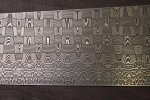- Joined
- Feb 24, 2000
- Messages
- 1,917
Back in 1991 I attended the ABS Damascus class in Washington Arkansas. Since then I have made lots of Damascus. I thought I would mention some things that have helped me and might help others.
1. A couple of years ago I put a pyrometer probe in my gas forge. Before I had the pyrometer I would judge the color of the billet and the flux activity before welding. Now, I use the temperature. It is much easier for me and I have not had a weld fail since.
2. A few years ago I re-did my gas forge and put two inches of insulation in it. That has made a huge difference. The forge heats up much faster and heats the billet up much faster.
3. I have experimented with different kinds of flux. Right now I am using anhydrous borax. With the anhydrous I use very little. That makes it easier on the forge floor, and there is less splatter when I weld the billet. Where I live in the desert the anhydrous lasts a long time. I just used the last of a gallon can which lasted several years and it was still good.
4. I set the initial weld with my hydraulic press. I use large flat dies and press the billet together all at once. This also has the advantage of reducing flux splatter in the initial weld.
After the initial weld I use my 100lb power hammer to draw the billet out.
I invite responses, but if you care to give advice I think it would be nice to provide a picture of your work like the picture below.

1. A couple of years ago I put a pyrometer probe in my gas forge. Before I had the pyrometer I would judge the color of the billet and the flux activity before welding. Now, I use the temperature. It is much easier for me and I have not had a weld fail since.
2. A few years ago I re-did my gas forge and put two inches of insulation in it. That has made a huge difference. The forge heats up much faster and heats the billet up much faster.
3. I have experimented with different kinds of flux. Right now I am using anhydrous borax. With the anhydrous I use very little. That makes it easier on the forge floor, and there is less splatter when I weld the billet. Where I live in the desert the anhydrous lasts a long time. I just used the last of a gallon can which lasted several years and it was still good.
4. I set the initial weld with my hydraulic press. I use large flat dies and press the billet together all at once. This also has the advantage of reducing flux splatter in the initial weld.
After the initial weld I use my 100lb power hammer to draw the billet out.
I invite responses, but if you care to give advice I think it would be nice to provide a picture of your work like the picture below.






